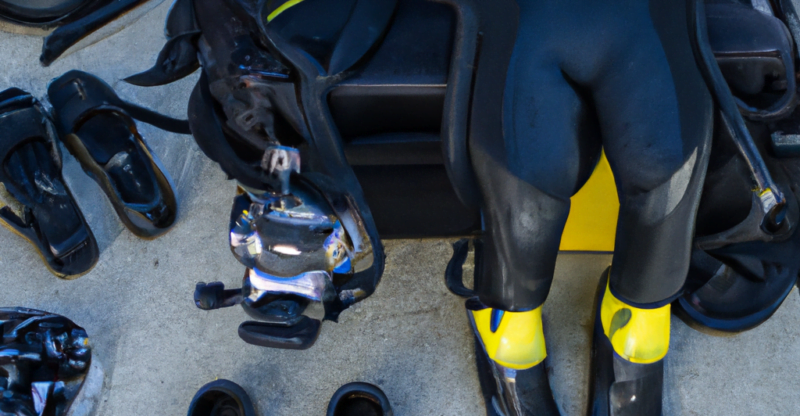Get Ready for Your Next Dive with the Best Scuba Diving Equipment
Diving with mask, snorkel and fins is an incredibly rewarding experience for those wanting to explore the wonders of the underwater world. The right combination of these three pieces of equipment can allow divers to move freely and efficiently, while also providing them with a clear vision and fresh air. Whether you’re a recreational diver or a professional explorer, having reliable scuba diving equipment on hand can make all the difference when it comes to safe and enjoyable dives.
Masks provide a comfortable way for divers to see clearly underwater by creating an air-tight seal on the face. Tempered glass lenses are adjustable and provide an unobstructed view of the environment. Snorkels allow divers to take short breaths while still wearing their headgear on the surface, while fins add additional thrust and maneuverability during dives.
When shopping for dive gear, it’s important to consider what type of diving activity you plan to do and in which conditions it will be used in order to choose the best models suited for your needs. Good quality masks, snorkels and fins should fit comfortably and offer features that contribute towards an enjoyable dive – whether it’s low-volume masks for freediving or flexible blades for increased propulsion – so that divers can get the most out of their underwater experience.
Wetsuit, Wetty, Steamer, Springy
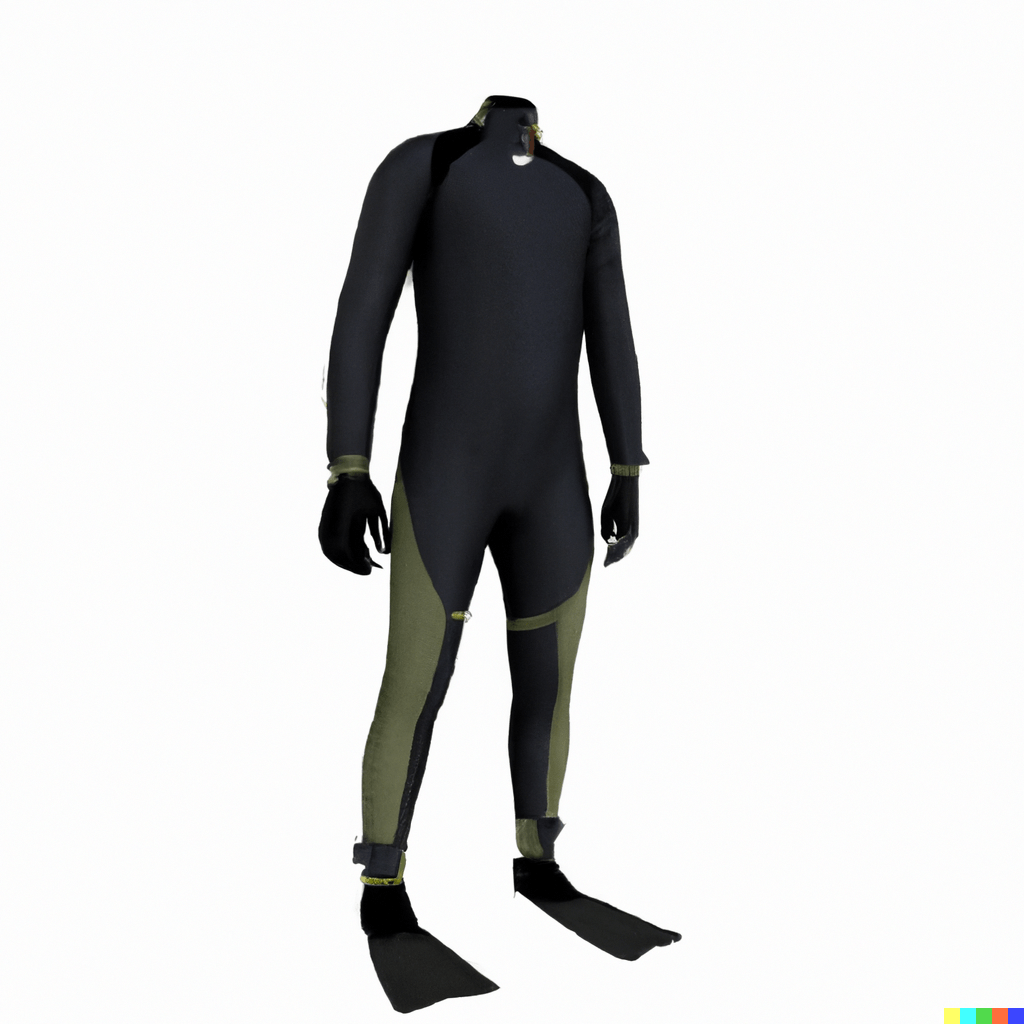
A wetsuit, also known as a wetty or steamer, is an essential piece of equipment for scuba divers. It helps keep the body warm by trapping a thin layer of water between itself and the skin which then becomes heated by the body. Wetsuits come in different thicknesses depending on how much insulation you are looking for. Also available are springys; these are shorty-style suits that provide less coverage than a full-length wetsuit but still provide good thermal protection from colder depths.
Regardless of the type of suit chosen, it’s important to make sure it fits properly for maximum comfort and performance. This can be done by putting on the wetsuit, gently pressing down against your body, and checking that there is no air leakage around any seams or wrists/ankles. If there is air leakage then it might require resealing with a neoprene solution before going underwater. A wetsuit should fit snugly with no wrinkles or baggy areas as this can affect mobility and potentially cause discomfort during dives.
Dry Suit
A dry suit is a type of protective clothing designed to keep the wearer warm and dry in cold, wet conditions. A drysuit provides an immediate barrier between the user and the environment; it is made of materials such as neoprene or nylon that is water-resistant and breathable, allowing moisture to escape while also keeping out any unwanted external elements. Generally, two types of dry suits are used for scuba diving: membrane (trilaminate) and neoprene. While both offer good thermal protection from cold depths, a neoprene suit provides more insulation than a membrane suit due to its thick material.
When choosing a drysuit for diving, it’s important to consider a few key factors such as fit, comfort, ease of donning/doffing, durability, and waterproofness. It’s recommended that a proper fitting be done before purchasing one so that the individual wearing it can adjust it according to their desired level of warmth and comfort. Additionally, divers should choose a suit with heavy-duty zippers that are easy to open/close and have no leaks when submerged in water.
Cylinder, Tank
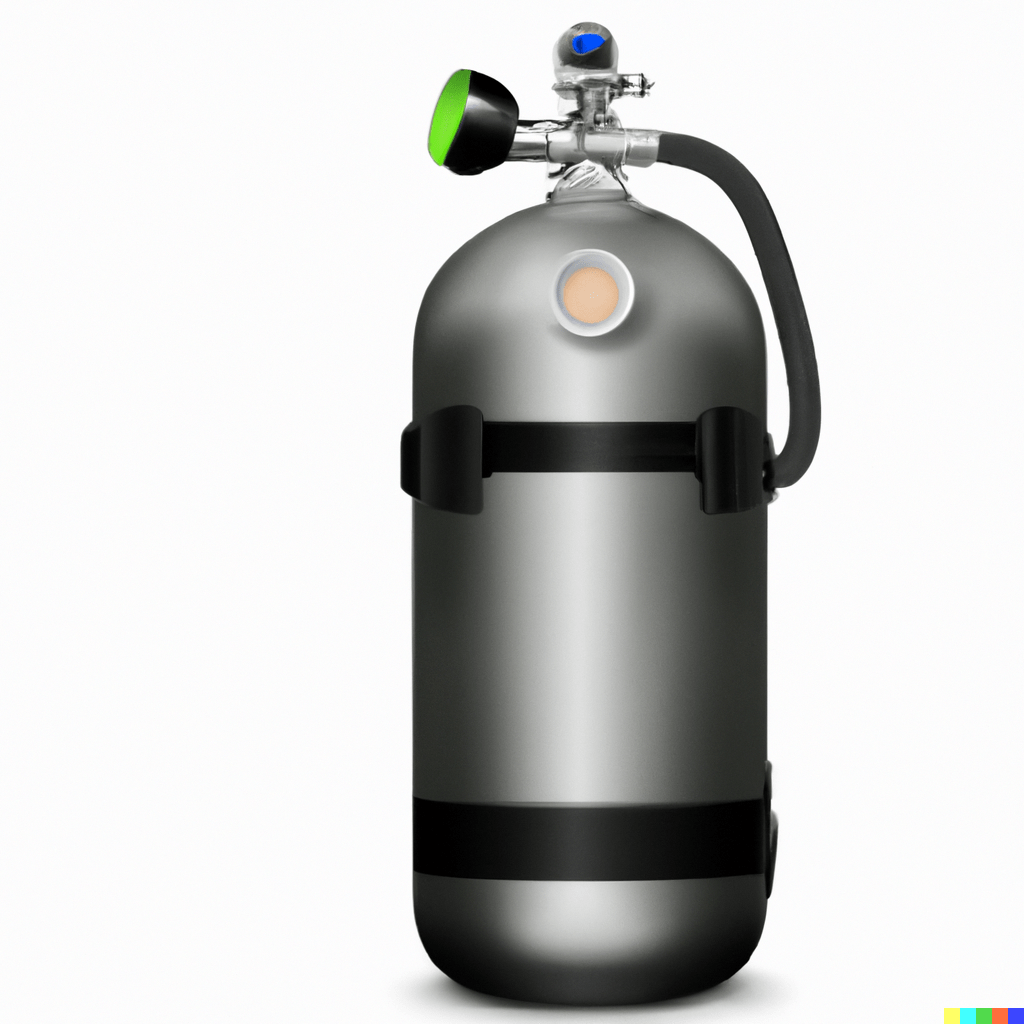
A scuba cylinder, also known as a tank or dive tank, is an essential piece of equipment used by divers for underwater breathing. It is typically composed of an aluminum alloy shell with steel, brass or rubber valves and a valve handle to open and close the tank without leaking air. Cylinders are pressurized with air or nitrox gases (compressed oxygen) depending on the type of diving being done and come in different sizes ranging from small pony bottles to large tanks that can hold up to several hundred atmospheres.
The choice of the cylinder will depend on many factors such as dive duration, depth requirements, gas contents, and weight capacity. Scuba cylinders should be regularly inspected for any signs of corrosion, damage, or wear and tear that might affect their ability to hold pressure safely. Additionally, they must be visually inspected at least once a year before diving to ensure they meet safety standards and are ready to use.
Buoyancy Control Device (BCD), Buoyancy Compensator (BC)
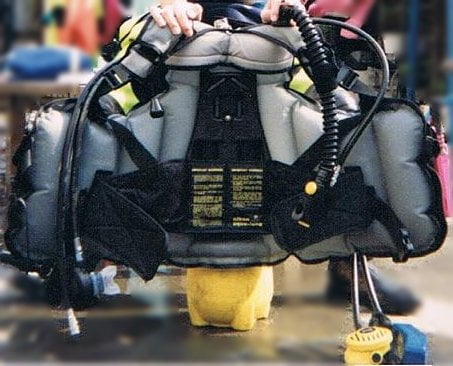
A Buoyancy Control Device, or BCD, is an essential piece of equipment for any diver. It is a special harness system that allows divers to control their buoyancy and maintain neutral buoyancy – the ability to remain in one place underwater without sinking or rising up. The BCD is connected around the diver’s waist with an adjustable strap and connects to an air bladder located in the chest area, which can be inflated or deflated depending on the diver’s needs.
A Buoyancy Compensator (BC) is an alternative type of BCD that uses a jacket-style design. This type of device utilizes two air compartments located on either side of the chest and abdomen areas which can be inflated while diving to provide additional buoyancy control. BCs also usually contain pockets and D-rings, allowing divers to attach accessories like slates, cameras, and torches. Unlike a conventional BCD, a BC cannot be deflated completely but provides more lift than a standard BCD for better weight distribution underwater.
Regulators: First Stage, Primary Second Stage, and Alternate Second Stage
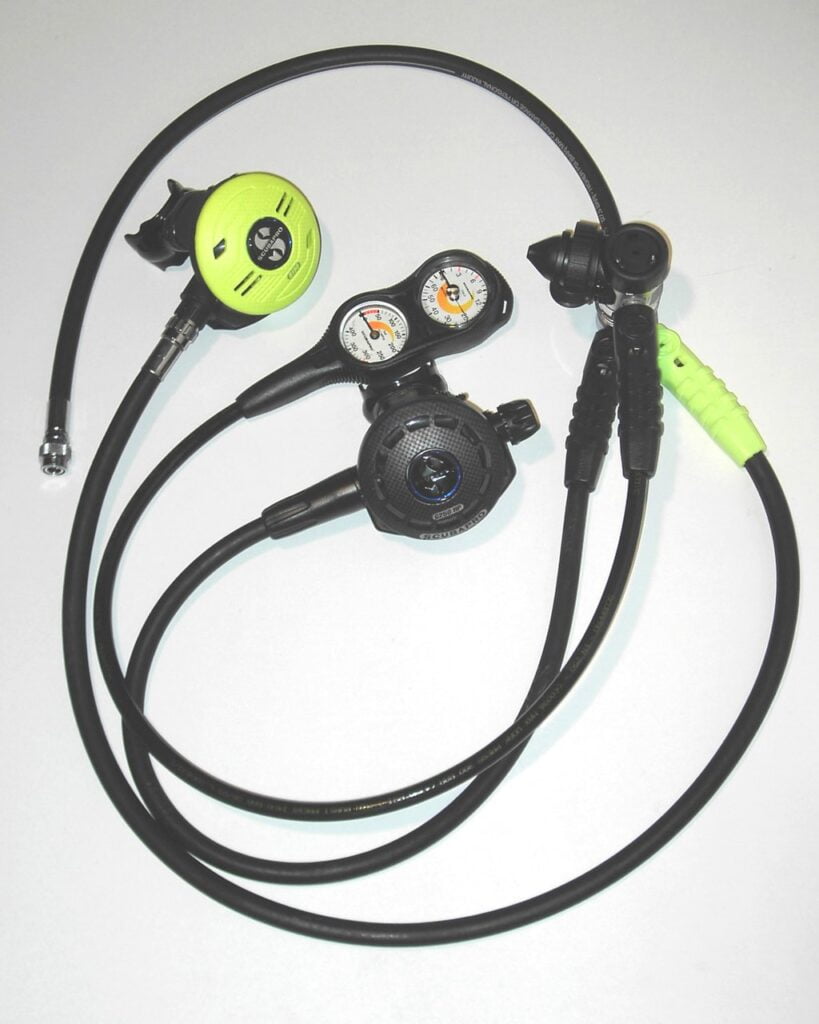
A regulator is the device that enables a diver to breathe safely underwater. It consists of two parts: a first stage, which connects to the cylinder valve and reduces the gas pressure, and a second stage, which filters and delivers air at ambient pressure. The primary second stage is typically located on the right side of the body and allows for easy regulation of airflow, while an alternate second stage can be added via an extra hose to provide additional air or act as a backup in emergency situations.
First Stage
The first stage of a regulator is the component that connects directly to the scuba tank. Its main purpose is to reduce the pressure of the gas inside, allowing it to be safely inhaled by a diver. This is achieved through the use of diaphragms and valves that work together to maintain a constant flow of air at ambient or atmospheric pressure. Additionally, this component also houses an oil chamber which helps protect and lubricate the internal components from wear and tear due to long hours spent underwater.
The first stage also features several high-pressure ports for attaching additional hoses, as well as low-pressure ports for connecting to the second stage regulator. It also contains a valve that allows divers to fine-tune their own airflow rate if needed. All these features make the first stage an essential part of any diving kit and must be regularly checked and maintained in order to ensure safe operation.
Primary Second Stage
The primary second stage is the component of a regulator that delivers air at ambient pressure to the diver. It usually attaches to the first stage via an extra hose and can also be attached via a rubber mouthpiece. It features a mouthpiece as well as controls for regulating the flow of air coming from the first stage. This allows divers to easily adjust their breathing rate while underwater, giving them more control over their dives.
This stage is typically located on the right side of a diver’s body, where it can be easily reached in case of emergency. It also consists of various components such as springs, levers, and diaphragms which help regulate airflow, allowing divers to take in just enough air without any sudden changes in pressure. As such, this component ensures user safety by allowing divers to customize their own breathing rate while underwater.
Alternate Second Stage
The alternate second stage regulator is designed for situations where a diver needs an additional air source. It is usually attached to the diver’s tank via an extra hose and can be used as a backup in case the primary second stage fails. This component also allows divers to use different air mixes and gases while underwater, allowing them to adapt to varying depths more efficiently.
The alternate second stage also requires specialized training before it can be safely used. It includes components such as a valve, diaphragm, lever, and spring which all work together to regulate airflow and provide proper breathing gas flow. Additionally, the alternate second stage must be regularly checked and maintained in order to ensure its proper functionality and user safety while underwater.
Instruments: The Submersible Pressure Gauge and Dive Computer
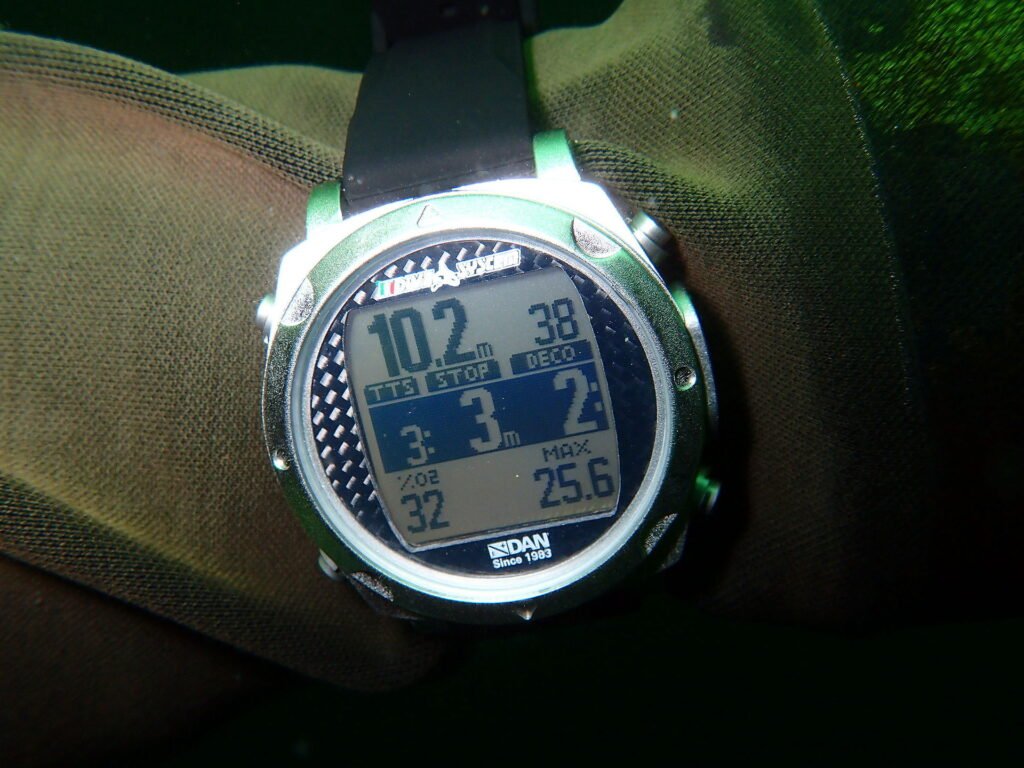
Submersible pressure gauges and dive computers are essential instruments for scuba diving. Submersible pressure gauges measure the pressure of a diver’s breathing gas, providing divers with the information necessary to prevent them from exceeding their maximum safe operating limit. Dive computers monitor a diver’s depth, time underwater and other important factors such as air consumption, in order to keep track of their safety limits during dives.
Both instruments feature liquid-filled diaphragms which provide accurate readings of water pressure at any given depth. Submersible pressure gauges typically feature analog or digital displays to alert divers when they are nearing their maximum operating depth, while dive computers typically employ LED screens that can store data from multiple dives. Additionally, both devices include alarms which sound when a diver’s safety limits have been exceeded.
Weights: Integrated Weights and Weight Belts
Weight belts and integrated weights are essential components of a diver’s equipment. Weight belts feature quick-release buckles and adjustable straps which enable divers to add or remove weights as needed. Generally, these weights have either lead shot, steel shot, or plastic beads to provide extra buoyancy. The amount of weight needed is dependent on the type of diving being performed, personal preference, type of exposure suit, and other factors that affect buoyancy control.
Integrated weights are built into the structure of certain wetsuits and drysuits to help divers achieve proper buoyancy control without the use of a traditional weight belt. These weights are designed to be distributed in specific areas for optimum weight distribution, balance, and comfort underwater. Some models even allow for additional pockets for other items such as cameras or knives. Both types of weights help divers maintain neutral buoyancy during dives in order to maximize their safety and comfort underwater.
Mask, Snorkel, and Fins
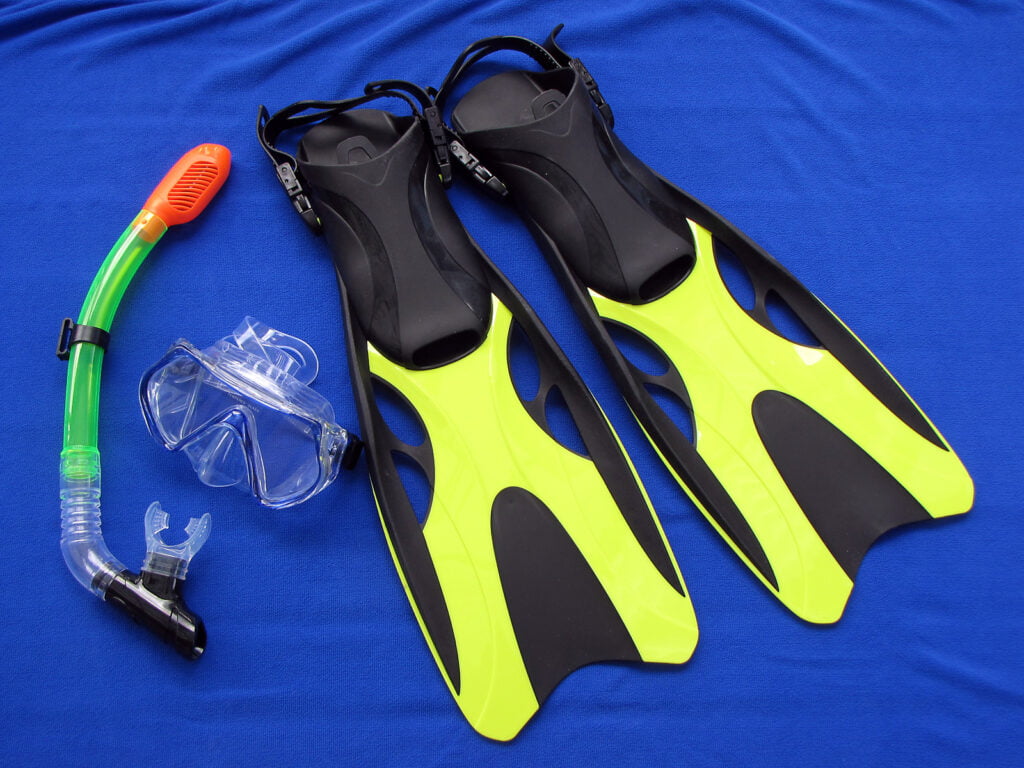
Masks, snorkels, and fins are essential pieces of equipment for underwater exploration. A good quality mask provides an air-tight seal on a diver’s face, enabling them to see clearly underwater and prevent the entry of water. Snorkels are designed to allow divers to breathe at the surface without having to remove their headgear, enabling them to explore longer without exhausting themselves. Fins provide propulsion underwater, helping divers swim faster with less effort.
In addition to basic models, more specialized masks, snorkels, and fins are available for specific types of diving activities or conditions. For example, freedivers may opt for low-volume masks that fit snugly on the face with minimal displacement in order to reduce drag during dives. Similarly, flexible long-bladed fins can be used by experienced divers for increased thrust and maneuverability underwater. Whether for recreational or professional use, the right combination of these tools can make any dive safer and more enjoyable.
Mask
Masks are essential pieces of equipment for scuba diving, providing a comfortable way for divers to see clearly underwater. Most masks feature tempered glass lenses which can be adjusted to fit the diver’s face and provide an unobstructed view of the underwater environment. The frame is typically made out of high-quality silicone or rubber, while some feature additional features such as corrective lenses or tinted lenses for glare reduction.
When shopping for a mask, size and comfort should be top priorities in order to ensure that it fits snugly on your face and does not leak. It’s also important to choose models which have anti-fog coatings on both sides of the lens, as well as straps with quick-release buckles that allow you to adjust or remove the mask quickly if needed. Different types of masks are available depending on your needs – from specialized models designed specifically for freediving to low profile designs that reduce drag in the water – so it’s worth doing your research beforehand.
Snorkel
Snorkels are essential pieces of equipment for divers looking to conserve air while exploring the underwater world. A good snorkel should be comfortable and secure, allowing you to breathe freely without having to constantly adjust it. Most snorkels have curved tubes with a flexible mouthpiece at one end and an exhaust valve at the other which works to prevent water from entering your lungs.
It’s important to choose a model that fits comfortably in your mouth and has an ergonomic design so that it doesn’t cause jaw fatigue or restrict your breathing. Look for features such as anti-splash guards, purge valves, and adjustable straps if you want additional convenience during your dive. Some advanced models even feature integrated GoPro mounts so that you can easily attach a camera for capturing all of your underwater adventures!
Fins
Fins are an essential piece of equipment for scuba diving, providing a powerful way to propel yourself through the water. They come in a variety of shapes and sizes to suit different needs, but most feature blades are made out of rubber or plastic which create thrust when swung back and forth.
When shopping for fins, you’ll want to look for ones that fit correctly and are comfortable over extended periods of time. It’s also important to consider the type of diving you plan on doing – such as freediving or deep sea – as your choice of fins will vary depending on the activity. Some specialized fins feature dual-blade designs or channels along the edges which can improve maneuverability in certain situations. Consider checking out models from top brands such as Cressi, Mares, Aqua Lung, and Atomic if you’re looking for great performance in the water!
Conclusion
Scuba diving is an amazing way to explore the undersea world and experience its beauty first-hand. It’s important to make sure you have the right gear before you go, as this can make all the difference in your experience. Look for fins that fit well and are comfortable over extended periods of time, as well as a snorkel that provides easy breathing and air conservation. Consider checking out top brands such as Cressi, Mares, Aqua Lung, and Atomic if you want reliable performance in the water! With the right setup, you can swim through the ocean with ease and enjoy its wonders in a safe and responsible manner. I’ve been scuba diving for years and it never ceases to amaze me!




